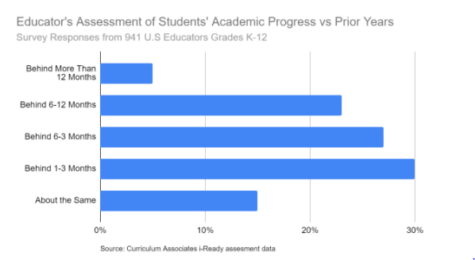The Covid Slide

Graph of poll results from teachers across the country shows learning losses.
Students are, on average, five months behind in math due to Covid interference last year (McKinsey, 2021). This Covid Slide is similar to the “Summer Slide” where students lose some of their progress in school while on vacation. Over the “Summer Slide”, it is calculated that students fall one month behind on achievement scores, however the Covid Slide is predicted to be much worse. The lack of in-person learning in schools expanded the difference in learning between high and low income areas and racial groups. In addition to falling behind in school, this loss in learning is expected to negatively impact lifetime earnings.
“We made it through about 80 percent of the units,” said sophomore Abbey Chun. “I definitely understand in-person math better because there is more accessibility to teachers and asking questions… they’re more approachable and it’s easier to ask and answer questions.”
Last year’s atypical schooling caused massive losses of learning. Along with the inability for most schools to have classes in-person, online school offered many additional challenges. Connection errors, mic and video problems, missing interaction, and lack of participation all contributed to falling behind in class. “Unfinished learning” is a term used by studies to describe “the reality that students were not given the opportunity this year to complete all the learning they would have completed in a typical year” (McKinsey, 2021).
“It was difficult to know who was engaged and who wasn’t,” said Sandra Bergeson, a high school math teacher. “But I think there were some students who were just naturally quiet so the inability to see them and to look at their work was really hard last year.”
The McKinsey study used test scores from the Curriculum Associates’ i-Ready in-school assessment and translated them into months of learning. While it is impossible to calculate the exact unfinished learning, the study compared the recent test scores to past years to predict how far behind they are currently. The statistics estimate five additional months of learning were lost because of Covid last year. Educators attempt to make up for this by teaching slower to allow students time to catch up. Over 97 percent of educators reported seeing some learning loss in their students over the past year when compared with children in previous years (CNBC, 2021).

“We’re not doing it necessarily right at the beginning of the year, but we know that there are pieces that are going to be missing as we go through different units,” said Bergeson. “IB, for instance, we’ve slowed down a couple of our pacing for our units because we anticipated [the students] didn’t learn or didn’t master some of that material. In geometry, we’ve touched base with Algebra teachers from last year to talk about some of those skills that we should emphasize.”
Economic and race factors also have an impact, increasing the amount of unfinished learning. “Students of color and low-income students suffered most. Students in majority-Black schools ended the school year six months behind in both math and reading, while students in majority-white schools ended up just four months behind in math and three months behind in reading” (McKinsey, 2021). “Students in predominantly low-income schools and in urban locations also lost more learning during the pandemic than their peers in high-income rural and suburban schools.”

It is estimated that these learning losses will have long term effects and impact future salaries. “Unfinished learning could reduce lifetime earnings for K–12 students by an average of $49,000 to $61,000” (McKinsey, 2021). “While white students may see lifetime earnings reduced by 1.4 percent, the reduction could be as much as 2.4 percent for Black students and 2.1 percent for Hispanic students.” Covid has undoubtedly set back math progress made last year and negatively impacted students.


